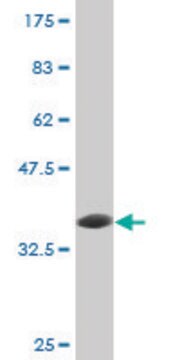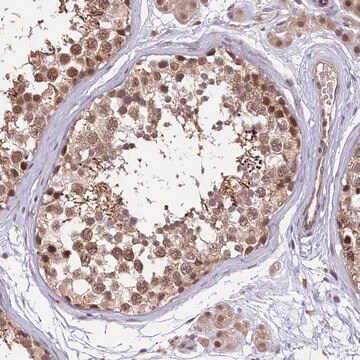E8655
Anti-E6AP antibody, Mouse monoclonal
clone E6AP-330, purified from hybridoma cell culture
Sinônimo(s):
Anti-E2F-6
About This Item
Produtos recomendados
fonte biológica
mouse
conjugado
unconjugated
forma do anticorpo
purified from hybridoma cell culture
tipo de produto de anticorpo
primary antibodies
clone
E6AP-330, monoclonal
forma
buffered aqueous solution
peso molecular
antigen ~100 kDa
reatividade de espécies
human, mouse, rat, monkey
técnica(s)
immunocytochemistry: suitable
immunoprecipitation (IP): suitable
indirect ELISA: suitable
microarray: suitable
western blot: 1-2 μg/mL using total cell extract from 293T cells
Isotipo
IgG1
nº de adesão UniProt
Condições de expedição
dry ice
temperatura de armazenamento
−20°C
modificação pós-traducional do alvo
unmodified
Informações sobre genes
human ... E2F6(1876)
mouse ... E2f6(50496)
rat ... E2f6(313978)
Descrição geral
Monoclonal Anti-E6AP antibody is a useful tool for the study of E6AP and its function in protein degradation. This antibody is specific for E6AP protein in rat, mouse, human and monkey.
Imunogênio
Aplicação
forma física
Exoneração de responsabilidade
Not finding the right product?
Try our Ferramenta de seleção de produtos.
Código de classe de armazenamento
10 - Combustible liquids
Classe de risco de água (WGK)
nwg
Ponto de fulgor (°F)
Not applicable
Ponto de fulgor (°C)
Not applicable
Certificados de análise (COA)
Busque Certificados de análise (COA) digitando o Número do Lote do produto. Os números de lote e remessa podem ser encontrados no rótulo de um produto após a palavra “Lot” ou “Batch”.
Já possui este produto?
Encontre a documentação dos produtos que você adquiriu recentemente na biblioteca de documentos.
Nossa equipe de cientistas tem experiência em todas as áreas de pesquisa, incluindo Life Sciences, ciência de materiais, síntese química, cromatografia, química analítica e muitas outras.
Entre em contato com a assistência técnica








